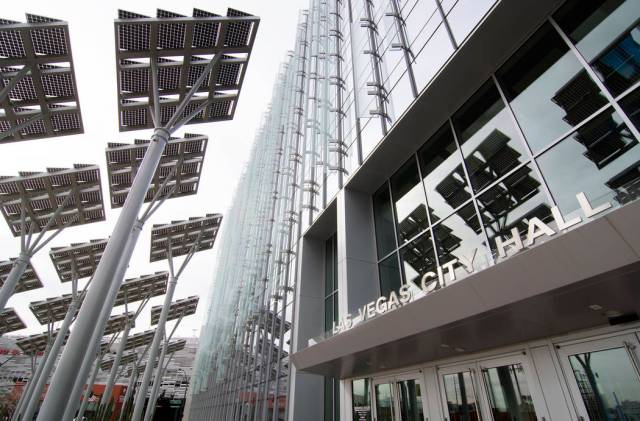
The city of Las Vegas is paving the way in Southern Nevada for its focus on public sector projects, science and technology and information technology. It ranked among the highest in three categories of the State of Nevada Innovation Awards. It scored high for two separate public sector projects, Science and was also one of the highest scorers in the technology division.
While the city was emerging from the Great Recession in 2013, officials said there was an effort to bring together residents, community leaders and policymakers to create plans that would make Las Vegas more livable, prosperous and resilient.
The result was a strategic planning session that set four priorities as a guideline: education, transportation, public safety and economic diversification.
It culminated in a city-by-design vision that’s part of master plans for the Las Vegas Medical District, downtown Las Vegas and an Innovation District.
The city is using technology to become more sustainable with a focus on generating solar power and replacing 42,000 streetlights with LED lighting. Annual energy costs have been reduced from $15 million in 2008 to less than $10 million in 2016. It’s even received the U.S. Conference of Mayors’ Climate Protection Award. Las Vegas is the first large city to achieve 100 percent of its retail energy from renewable sources, meaning every public building, park, traffic light and streetlight is powered by renewable energy.
The downtown Innovation District creates a center for testing groundbreaking technology for alternative energy, citizen participation, transportation and social infrastructure.
The city is not only promoting but accommodating autonomous vehicle licensing and testing. It has integrated the Regional Transportation Commission’s state-of-the-art regional traffic signal system into city roads. It has piloted Lida mapping of downtown roadways to create 3-D data used for programming autonomous vehicles.
Building on the tech foundation provided by Switch, the city’s Innovation District is a place for collaborative efforts between the city and technology partners. The city partnered with Navya, a French driverless electric vehicle manufacturer, and Keolis, a global leader in operating public transportation systems, to test autonomous electric shuttles in downtown Las Vegas. This was the first autonomous electric shuttle to hit a U.S. street.
The Innovation District is serving as a test for Las Vegas’ Internet of Things innovation project that will be deployed across the county. The pilot wireless network went live in March 2017 with monitoring sensors for traffic flow and one for monitoring the environment was installed in April.
“We’re doing some groundbreaking things that are being looked at by other jurisdictions,” said Michael Sherwood, director of information technology for Las Vegas. “We’re at the leading edge right now where we’re focused on creating a quality experience for citizens and tourists in the downtown area.”
Sherwood said the Innovation District acts as an incubator area and allows the city to test new concepts and technology before making large investments. The city is testing Amazon Alexa this time, he said.
“Not everybody can have a smartphone or desktop computer,” Sherwood said. “You have an elderly population and special-needs individuals that may not have access to all those tools. We wanted to come up with a way on how to link citizenry with their government and provide them information in helping negotiate the city.”
Sherwood said the city is working on pedestrian safety measures by using cameras and analytics to try to have safer streets for them and avoid fatalities and injuries.
“If we can use technology and find ways to reduce those opportunities from transpiring, that’s truly what technology is here for,” Sherwood said.
The city is looking at sensors that can not only determine if a bin is full but if it has a pungent odor, Sherwood said. No one wants someone’s memory of Las Vegas to be a full and smelly trash can, he said.
“We hope these sensors not only create a better user experience but streamline government efficiency,” Sherwood said.
The city is looking at putting sensors on sprinkler pipes in parks so that if a pipe breaks, the water will shut off and alert staff that it’s broken, Sherwood said. Not only does that keep a citizen from seeing it but it doesn’t require inspections, he said.
During the Consumer Electronics Show, UNLV students won a prize by taking city data of streetlights and developing an application to determine which streetlights are out before a citizen calls, Sherwood said.
“We look at the amount of electricity used at the light and if it is used during the day, that light might have a bad photo sensor,” Sherwood said. “If it’s not using any electricity it’s probably out. Streetlights being out can mean an area is more prone to crime, and it’s important to fix it as soon as possible.”
Las Vegas is ranked No. 1 in the nation from the U.S. Open Data Census, which measures openness of key datasets. Data available online includes mapping tools, such as zoning and parcels, and all of it is machine-readable with complete data set tables for software developers to render visualizations or to build into applications.
Las Vegas plans to undertake a communications and marketing campaign to generate interest and activity in the Innovation District. City officials said they want the district to inspire stakeholders to come together to create a technological ecosystem that’s constantly evolving and be a positive for everyone who comes to downtown Las Vegas.